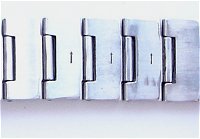
Click on image to enlarge.

|
1. Separating the clasp - The first step before removing any links is to open the bracelet out so that you can work on it more easily. To do this
you need to remove the spring bar from the clasp so that you have the bracelet separated: If you hold the clasp in your left hand it is the spring bar
on the left side of the clasp. You can use a bradawl or
spring bar removal tool
to push down on the spring bar, compressing it so that it will come out of the retaining hole and this will release the two parts of the clasp. Be careful
that the spring bar does not ping across the room, as it is the only one you have and losing it will be an inconvenience.
|

|
|
You will notice that there are two holes for this spring bar on the clasp giving you the opportunity to make a small adjustment to the bracelet length should you need it.
|

|
|
2. Removing a link - Identify the first link to be removed and using a bradawl push out the pin securing that link. Follow the direction of the arrows
imprinted on the underside of the link.
|

|
|
The pin should be pushed about 2 or 3 mm and then pulled from the other side using the pliers. This step is easier using
the Bracelet Link removal tool! |

|
|
When the pin is pulled out completely the link will separate from its neighbour. In some cases it releases a small metal ferrule that sits in the central part of
the joining link. This ferrule will fall out on to your worktop or the sheet (that you carefully placed on the floor!) You will need the ferrule later so don't lose it.
Repeat the process on the other side of the link so that you now have removed one entire link and have two pins (and two ferrules if applicable) sitting safely to one side.
Repeat this process for the number of links that you need to remove. |

|
|
3. Connecting the bracelet back together - If your watch strap links include the small ferrule, this needs to be put back into the central part of the link
that you are joining back together. This time working in the opposite direction to the arrow on the link, push the pin back through the link to engage the link
(and ferrule).
|

|
|
If necessary you can carefully tap the pin back into place with the hammer or push the end against a hard surface such as the back of the pliers.
|

|
|
4. Reconnecting the Clasp - Reconnecting the clasp is a simple reversal of the disconnecting process. Try on the watch and if it is a little loose or a little tight you can
adjust the clasp by inserting the spring bar into the alternative set of holes. After the adjustment you will have spare links, pins and possibly ferrules. These will be useful if you need to replace a pin, ferrule or link in the future, so they are worth keeping! |

|